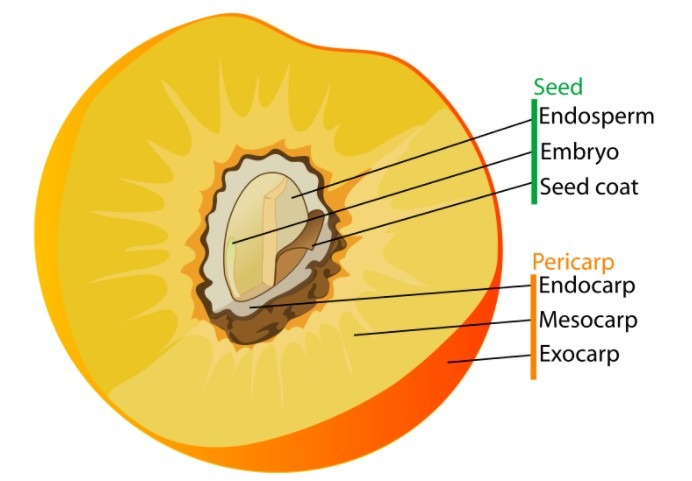Fruits are so versatile; you can do much with them. Their tart and sweet taste is both revitalizing and fortifying. It can be eaten as it is or used to make a number of delicious recipes. To maintain a balanced diet and healthy lifestyle, it is necessary to eat three or four servings of fruits daily.
The summer season has the best fruits; there is no doubt about it. In summer, there is nothing more refreshing or energizing than eating fresh fruits. Summertime fruits are extremely nutritious and available in a wide variety.
A wonderful variety of summertime fruits includes drupes, also known as stone fruits. Drupes are a very interesting group of fruits. All of us have probably eaten a lot of drupes, without even knowing it. It is okay if you don’t know what these are. This article mentions all the things you need to know about drupes.
What are Drupes?
In botany, drupe is a simple fleshy fruit that has a single seed. It is usually derived from a single ovary of an individual flower. The ovary has several layers; the outer wall is a covering of thin skin called the exocarp. The middle layer is thick or fleshy called mesocarp (fruit), but in some cases like almonds, it is tough, and in the case of coconuts, it is fibrous. The inner layer is called pit or endocarp, and it is hard and stony.
The pit mostly contains one to three seeds or kernels, out of which the only one develops fully. In some aggregate fruits, many small drupes are joined together. These fruits, called drupelets, are formed by many fused carpels.
Examples of Drupes
Blackberry: https://upload.wikimedia.org/wikipedia/commons/a/af/Black_Butte_blackberry.jpg
Simple drupes generally include peaches, apricots, plums, cherries, and olives. Some other representatives of drupes are mangoes and walnuts. Whereas, an example of fibrous drupe includes coconut. It is classified as a dry fruit because of its fibrous husk, but actually, it is a drupe.
Blackberry or raspberry are not true berries; they are called bramble fruits and are classified as drupelets.
Classification of Drupes
Drupes are in a full season in the summertime. You can easily find all kinds of drupes in the market; they are commonly available. Drupes are mainly classified into four varieties.
- Freestone
In a freestone drupe, the stone or pit can be easily removed from the flesh. It is not connected to the flesh of the fruit. Fruits in this classification include peaches, plums, prunes, cherries, and nectarines.
- Clingstone
In a clingstone drupe, the stone or pit cannot be easily removed from the flesh. It completely clings to the flesh of the fruit. Drupes in this classification include apricots, olives, and mangoes.
- Tryma
Tryma drupes are also called nut-like drupes or drupaceous nuts. They actually grow within a fibrous husk covering the fruit. Drupe nuts in this classification include walnuts, almonds, areca nuts, and even coconuts.
- Drupelet
As discussed above, drupelets are aggregates or clusters of drupes that have a hard seed. Fruits in this classification, which have small seeds, include bramble fruits like raspberries and blackberries. Fruits that have a larger seed include peppercorn and palm.
Uses of Drupes
All of the drupes mentioned above can be eaten raw as they are, and you can also use them in different food and drink preparations. There is so much you can do with these. Drupes can even be grilled, just brush them lightly with olive oil and season with salt and pepper to taste, for a fantastic addition to summertime grill-outs.
Fiber Content of Drupes
Unripe fruit: https://upload.wikimedia.org/wikipedia/commons/thumb/3/31/Black_Pepper_%28Piper_nigrum%29_fruits.jpg/120px-Black_Pepper_%28Piper_nigrum%29_fruits.jpg
Besides being extremely plump, juicy, and tasty, drupes are very nutritionally dense. They have high-fiber content and a relatively light calorie count. The fiber content of different drupes is as follows.
- One medium nectarine has 2.4 grams of fiber and 63 calories.
- One medium plum has 2 grams of fiber and 60 calories.
- One cup of cherries without pits has 2.5 grams of fiber and 77 calories.
- One cup of apricots has 3.3 grams of fiber and 79 calories.
- One piece of coconut has 4.1 grams of fiber and about 150 calories.
- One cup of raspberries has 8 grams of fiber and 65 calories.
Interesting Fact about Drupes
A fascinating fact about drupes is that they work with nature. Animals usually eat fruits that are attractive and then discard the seed. Sometimes the endocarp is ingested with the fruit, where it travels through the digestive tract and is then excreted. The seed ingested by then is all ready for germination and to become a new plant.
Final Words
If you weren’t already, this article will make you a drupe nut and increase your food trivia. Drupes or stone fruits are an amazing group of fruits. They are available during the summer season and have high amounts of fiber and low calories. They are delicious and easily available. We encourage you to go out and get these. Enjoy them as an afternoon snack, or even incorporate it into your meal – your call!

